
Author: Ian, Xinwei, Severin, MT Capital
TL;DR
1.DePIN Overview: Decentralized Physical Infrastructure Network (DePIN) combines the physical world with Web3, reduces costs and improves efficiency through decentralized technology, and is widely used in computing, storage, wireless networks and other fields, from traditional fixed devices to new generation portableand wearable devices, the market prospects are broad.
2.Investment trends and projects: The DePIN project showed significant growth in both bull and bear market cycles, with project types covering wireless networks, maps, Internet of Vehicles, agriculture, drones, weather, energy and other aspects.Investment institutions have expanded from Europe and the United States to Asia, and the number of participating institutions and investments has continued to increase, showing a strong interest in the DePIN field.
3.Market demand and potential: There are many types of emerging DePIN markets, including health data, weather, energy, bandwidth, AI and mobile phones, etc., with huge market space and high growth rates.Especially the energy and mobile phone markets have huge potential, and the year-on-year growth rate of the health data and AI markets is also very considerable.
4.Project Ecology and Blockchain Selection: Ethereum and Solana have become the main selection chains for existing DePIN projects and emerging DePIN projects respectively.With high performance, low cost and strong community support, Solana has attracted a large number of new projects and has gradually become the preferred platform for DePIN projects.Representative projects such as Render, Helium, Hivemapper, etc. showcase the diversified applications of DePIN.Core players such as Solana and IoTeX provide strong technical support and ecological environment for the DePIN project, promoting the rapid development of DePIN.
5.Modular blockchain trends: The modular design significantly enhances the scalability and adaptability of DePIN.Through standardized interfaces and interchangeable components, DePIN can flexibly adapt to different application scenarios and technical needs, thereby promoting rapid network deployment and maintenance.
6.The evolution of token economy: From the early fixed incentive model to the current dynamic incentive mechanism, DePIN projects such as Helium ensure the sustained growth and healthy development of the network by adjusting incentives for new and old equipment, regional incentive policies and time period incentive adjustments.
DePIN definition
DePIN, full name Decentralized Physical Infrastructure Network, is literally interpreted as “a decentralized physical infrastructure network”.Among them, “De” means decentralized, “P” means physics, “I” means infrastructure, and “N” means network.
The core definition of DePIN is to bring real-world users into Web3, achieving low cost and socialization through decentralized networks.In the current world, especially in the physical business field, DePIN achieves the goal of reducing costs and increasing efficiency through decentralized technology.
In previous research and reports, DePIN often focuses more on infrastructure, while this report (for the full version of PDF, please download it on the official website) focuses more on the decentralized part, trying to show a variety of future generationsDiverse DePIN markets and investment opportunities.
DePIN’s project type
Classic DePIN device:
Features: These devices are usually not mobile and are usually fixed in a certain position.
Main services: including computing, bandwidth and storage.
Market characteristics: The market of classic DePIN projects is more popular with technology, especially in fields such as AI computing power, and is more sought after by funds and traffic.This type of market is large in scale, but fierce competition, and it is a red ocean.
Representative projects: Filecoin, RNDR, etc.
New Generation DePIN Devices:
Features: These devices are small and flexible, and can be carried around or even worn.
Main business: life-related services such as health monitoring, weather forecasting and mobile phone functions.
Market features: The market of the new generation of DePIN projects is more life-oriented and low-cost, suitable for daily applications.This type of market has a wide variety of applications and a wide range of applications. It still needs to be explored in depth. It is a blue ocean with huge potential.
By comparing these two generations of DePIN projects, we can see that DePIN technology is constantly developing and application scenarios are constantly expanding.From traditional fixed devices to more flexible and portable devices today, DePIN’s market prospects are becoming more and more broad, covering a variety of needs from high-tech fields to daily life.The traditional DePIN market is large in scale and is a fiercely competitive red ocean; while the innovative DePIN market has a wide variety of applications and a wide range of applications, which still need to be explored in depth. It is a blue ocean with huge potential.
DePIN Investment New Ecosystem
The number and types of DePIN projects have increased significantly during this bull market cycle. New generation lightweight DePIN projects have been frequently released, and new wearable devices such as AI, bracelets, watches, etc. have been added to collect health data, as well as a large number of portable lightweight physical equipment DePIN.
2022.1.1 – 2023.1.1
There are 19 DePIN projects in total, with the average financing amount disclosed with the amount of financing being 18M. After excluding Helium’s D round of large-scale financing, the average financing amount is 5.9M.
The types of projects are wireless networks, maps, Internet of Vehicles data, agriculture, drone images, weather, power market, and DePIN infrastructure. Among them, the number of wireless network projects is the largest, up to 7.
2023.1.1 – 2024.1.1
There are a total of 9 DePIN projects, with the average financing amount disclosed with an average financing amount of 7.2 M, which is significantly lower than in 22 years (bear market), and the quota is increased by 22% compared with 22 years.
Project categories include wireless networks, decentralized computing power, map/geospatial data, weather, DePIN infrastructure, and significantly reduced financing amount and categories.(The bear market requires more reasonable business scenarios and models)
2024.1.1 – 2024.5.20
There are a total of 26 DePIN projects, with the average financing amount disclosed is 6.5M, the amount of financing has increased significantly and the financing amount has decreased.
Project categories include decentralized computing power, Internet of Vehicles, Internet of Things, Wireless Network, FHE, Map, Meteorology & Environment, Bandwidth, DePIN infrastructure, mobile phones, energy, storage, hybrid reality
New first-level financing types that have not been disclosed: wearable and portable equipment types such as AI, VPN, bracelets/watches (health data)
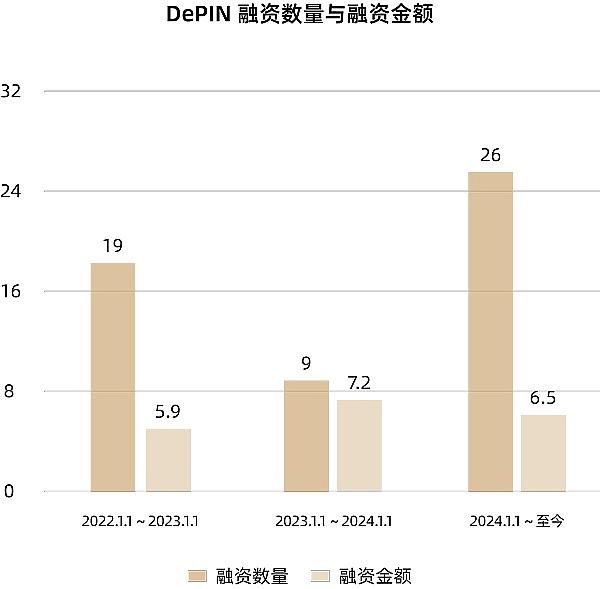
source: MT Capital
DePIN Number of projects and institutions
The DePIN participating institutions in the previous cycle were dominated by Europe and the United States, and more Asian institutions gradually emerged in this round of DePIN cycle, demonstrating the strong interest of Asian institutions in DePIN.The number of DePIN projects has also increased significantly, with the total number of second-level DePIN projects exceeding 135, and the total number of first-level DePIN projects exceeding 130.
project:
•Secondary market projects: 137
•>$1B FDV: 20 pieces
•$500M – $1B: 19
•$100M – $500M: 48
•$50M – $100M: 16
•$30M – $50M: 14
•$10M – $30M: 12
•<$10M: 6
• Primary market projects: 133
• Since the start of the current bull market cycle (from October 2023 to the present), a total of 8 projects have raised more than $2 million in funding and 6 projects have raised more than $10 million in funding.
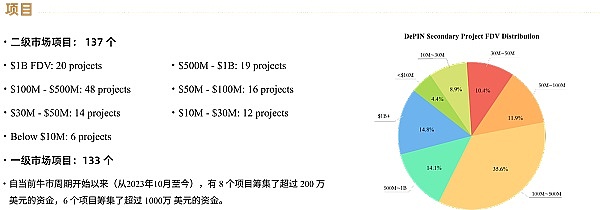
source: MT Capital
mechanism:
Last cycle:
•Andreessen Horowitz (A16z)
•Multicoin Capital
•HashKey Capital
•IOSG Ventures
•Spartan Group
•Borderless Capital
•Lattice Ventures
•Variant Fund
•Delphi Digital
•Big Brain Holdings
•Cogitent Ventures
This cycle:
•OKX
•Animoca Brands
•JDI
•IoTeX
•FMG
•Waterdrip Capital
•MH
DePIN Market Demand
In the last cycle, the DePIN sub-track represented by computing power, storage, wireless networks and maps, there are still emerging projects emerging in the DePIN sub-track.This cycle has added emerging sub-track categories such as wearable devices, weather, energy, bandwidth, AI and mobile phones, mainly based on health data.
From the market demand side, the energy market and the mobile phone market have a huge market space. The health data market and the AI market not only have a large market space, but also have a very high year-on-year growth rate, and the market size is very objective.
Market: (number of primary market projects +number of secondary market projects)
Health (5+/), Weather (9+1), Energy (15+10), Computing Power (17+29), Storage (7+19), Wireless Network (9+11), Bandwidth (6+4), Map (3+2), AI (8+13), Mobile (5+)
Number of market projects in the previous cycle
•Computing power: 17+29
•Storage: 7+19
•Wireless network: 9+11
•Map: 3+2
Number of projects in emerging markets
•Health Data (Wearable Device): 5+ /
•Weather: 9+1
•Energy: 15+10
•Bandwidth: 6+4
•Mobile phone: 5+
•AI: 8+13
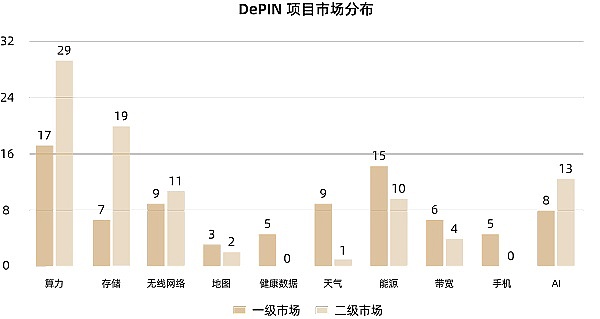
source: MT Capital
Market size and growth rate
•Health Market: $243B, CAGR 17%
•Weather Market: $7B, CAGR 7%
• Energy Market: $880B, CAGR 8.4%
•Computing power market: $95.7B, CAGR 6.8%
•Storage Market: $108B, CAGR 22%
•Wireless Network Market: $500B, CAGR 12%
•Bandwidth Market: $8.6B, CAGR 13.75%
•Map Market: $19B, CAGR 12.5%
•AI Market: $150B, CAGR 36.8%
•Mobile phone market: $484B, CAGR 7.3%

source: MT Capital
Public chain selection and device type

source: MT Capital
Currently, there are the largest number of DePIN projects in the secondary market on the Ethereum chain, with a total of 70 DePIN projects selected to be built on Ethereum, accounting for 81% of the total.
Among the first-level projects that have been collected, the number of Solana ecological projects is 28, accounting for 62% of the overall proportion.Solana is gradually becoming the first public chain for the new cycle of DePIN projects.

source: MT Capital
From the perspective of equipment type, there are more new projects in energy and sensor equipment types.And more projects with Wearable, Portable, and Home Device devices as physical hardware have begun to emerge in the primary market.
DePIN Full Industry Chain
Upstream supply chain
1. Hardware manufacturing and supply
Hardware supplier: produces various devices and sensors used in DePIN networks, such as GPUs, servers, IoT devices, wireless devices, etc.For example, the LoRaWAN hotspot for the Helium network, the dash recorder for the Hivemapper.
Professional hardware manufacturers: Some professional hardware manufacturers provide customized hardware for specific DePIN projects, such as Filecoin storage miners, Render network GPUs.
2. Chips and semiconductors
Chip manufacturers: such as NVIDIA and AMD, offer high-performance GPUs for computing networks such as Render and Akash, which are at the heart of handling AI workloads and complex computing tasks.
3. Internet of Things devices
Sensor manufacturer: Provide sensor equipment required for environmental monitoring, traffic data collection, etc.For example, the Bluetooth sensor in the Nodle network, Silencio’s noise pollution detector.
Smart devices: Such as smartphones and other mobile devices, which can be used as part of a sensor network for data collection and transmission.
4. Electricity and Energy Equipment
Energy equipment supplier: Provides solar panels, wind turbines, energy storage batteries and other equipment used in decentralized energy networks.Such as solar panels and battery systems in the Daylight Energy network.
Midstream Industrial Chain
1. Network operation and maintenance
Network operators: such as Helium and Hivemapper, manage and maintain the normal operation of decentralized networks, including the management of nodes, data transmission and storage.
Service provider: Provide network infrastructure services, such as cloud computing services, storage services, etc.
2. Software and platform development
Blockchain platforms: such as Solana and IoTeX provide basic blockchain technical support for DePIN projects, including smart contract execution, data storage and verification.
Software Developer: Develop software platforms and tools for managing and operating DePIN networks, such as the distributed storage management platform provided by Filebase and the video stream management tool provided by Livepeer Studio.
3. Data processing and analysis
Data Analytics Company: Process and analyze data collected from sensor networks to provide users with valuable insights and services.
AI and machine learning services: such as Beam, provides cloud-based AI computing services, distributing model training and inference workloads to decentralized GPU networks.
Downstream industrial chain
1. Applications and Services
Enterprise customers: Use the services provided by the DePIN network to enhance their business efficiency. For example, logistics companies use Hivemapper map data, and agricultural companies use Geodnet’s high-precision positioning data.
Consumer applications: such as Teleport’s shared travel application and DIMO’s vehicle data platform, which provide consumers with convenient services and receive rewards through the data contributed by users.
Smart cities and public infrastructure: Use data and services from decentralized networks to optimize urban management and public services, such as energy management, traffic management, etc.
Modular/Data layer/Intermediate layer
Modular blockchain optimizes the scalability, security and flexibility of blockchains by dividing core functions such as execution, consensus, data availability, and settlement into different layers.For example, Ethereum improves data availability and processing power by adopting sharded architecture and rollup, while Cosmos achieves cross-chain interoperability and highly customized through the IBC protocol and Tendermint consensus mechanism.The advantages of modular blockchain include higher transaction processing capabilities, enhanced security and greater development flexibility, which will further promote the development of blockchain technology in the future.
DePIN’s modularity trend significantly enhances its scalability.The modular design allows DePIN to flexibly adapt to different application scenarios and technical needs, simplifying network deployment and maintenance through standardized interfaces and interchangeable components.For example, the Render network achieves the expansion from image rendering to AI model training through a modular structure, increasing the network’s service scope and market potential.Additionally, Filecoin’s modular design allows it to expand storage services and add thermal storage and data computing capabilities, further enhancing the practicality and appeal of its network.The modular trend not only improves the technical compatibility and upgrade capabilities of the DePIN network, but also enables individual modules to independently develop and optimize, thereby accelerating innovation and progress in the entire network ecosystem.This flexible and efficient architecture greatly improves the scalability of DePIN, allowing it to respond more quickly to market demand and technological changes, and promote the widespread application and development of decentralized infrastructure.
Representative Project
DePHY
DePHY’s development framework designed for DePIN significantly reduces development costs and time through key functions such as message layer, DID (Device ID), open source hardware design, off-chain computing network and resolution layer, and supports any standard interface hardware to achieve rapid development costs and time., efficient and secure decentralized infrastructure project deployment.
PINGPONG
PINGPONG is a DePIN liquidity and services aggregator that optimizes and maximizes mining revenues across multiple networks through innovative tools and solutions.
DePIN track platform and players
Solana
Solana is becoming DePIN’s new super infrastructure.Solana’s high performance, low network fees, a strong community of developers and users, and high purchasing power make it the preferred launch network for many DePIN projects.Some of the established DePIN star projects such as Render and Helium have achieved better development after migrating to Solana, which shows the vitality brought to the DePIN project by Solana’s strong infrastructure and extensive community user base.Solana has gradually attracted emerging and cutting-edge DePIN projects in different categories including Grass, Natix, Exabits, and is gradually improving its DePIN ecosystem.
Representative Project
Render
Render Network is a decentralized GPU rendering platform that uses blockchain technology to connect artists with GPU providers to achieve scalable, cost-effective rendering solutions.
Hivemapper
Hivemapper is a decentralized map network that uses blockchain technology and crowdsourced dash recorder data to create detailed real-time maps.
Helium
Helium is a groundbreaking DePIN project that creates a decentralized wireless network that allows IoT devices to connect globally through distributed hotspot networks.
Natix:
Natix Network is a blockchain-based crowdsourcing camera network used to create real-time world maps.
Exabits:
Exabits is a decentralized infrastructure for artificial intelligence and computing-intensive applications.It allows users to provide distributed GPU services, data storage, or expertise to the AI community without the need for central authority or intermediaries.
Grass:
Grass is a DePIN project developed by Wynd Network that allows users to monetize their unused network resources by adding their networked devices to a decentralized network designed to provide data for AI training.
EV3
EV3 is an investment company driven by investment philosophy and supports outstanding entrepreneurs who build DePIN.By investing up to $1 million in early stage projects, EV3 aims to unlock the next $100 trillion global GDP through next-generation open infrastructure networks such as telecommunications, logistics, energy, cloud computing and artificial intelligence.Founded by institutionally trained investors Mahesh Ramakrishnan and Salvador Gala, EV3 combines deep industry expertise and long-term partnerships to gain support from leading investors.
Representative Project
3DOS
3DOS is the world’s largest decentralized on-demand manufacturing network, aiming to innovate the manufacturing industry through blockchain technology and 3D printing.The platform allows anyone to upload designs, receive royalties, and manufacture on demand worldwide.
Zonal
Zonal is developing a decentralized network based on micro-positioning protocols that leverage wireless communication technologies such as ultra-wideband (UWB) and Bluetooth Low Energy (BLE) to provide highly reliable global and indoor positioning services to validate real-world interactions.The goal is to create a unified protocol that provides location verification tools for a variety of services and businesses.
XNET
XNET is a next-generation mobile operator that uses blockchain technology to build a decentralized network.By using CBRS spectrum, XNET aims to build a reliable, industry-level neutral host network.The goal of the project is to solve the inefficiency and capital-intensive problems of the telecommunications industry through its distributed wireless access network (RAN).
IoTeX
IoTeX is an open platform for modularly constructing AI+DePIN infrastructure, aiming to open up the connection channels between smart devices and real-world data and Web3, allowing Web2 to easily and effectively access the blockchain and create decentralized multidimensional data and scenarios.Open the real world ecology.Through modular construction, developers can use China Unicom to fully innovative applications in Web3, including smart wearables, Internet of Vehicles, green energy, environmental data, etc., from smart life to smart industry.
As of the first quarter of 2024, the IoTeX network had 108 active nodes with a total staking value of US$29 million, a 73% increase from the previous quarter.The average pledge participation rate reached an all-time high of 40.6%.In addition, node rewards increased by 71% month-on-month to $3.3 million.
IoTeX provides a complete “plug and play” product and tools to enable blockchain-powered IoT applications to be efficiently built and deployed.The platform is divided into four layers: hardware layer, middleware, tool layer and blockchain layer.Since its inception, IoTeX has raised more than $90 million in funding to support its R&D and market expansion.IoTeX’s solutions support various IoT ecosystems, such as sharing economy, smart homes, autonomous driving and supply chain management.
Representative Project
Network3
The Network3 project is a Layer2 blockchain platform integrating AIoT technology, aiming to provide AI developers with efficient model training and verification tools, while enabling users to earn cryptocurrency by running nodes.
Inferix
Inferix is a decentralized GPU visual computing platform dedicated to 3D/AR/VR rendering and AI inference.
Wayru
Wayru Network is a decentralized wireless network that implements various intelligent functions through WayruOS and Wayru Connectivity Superapp.
DePIN subdivision track divided by physical hardware devices
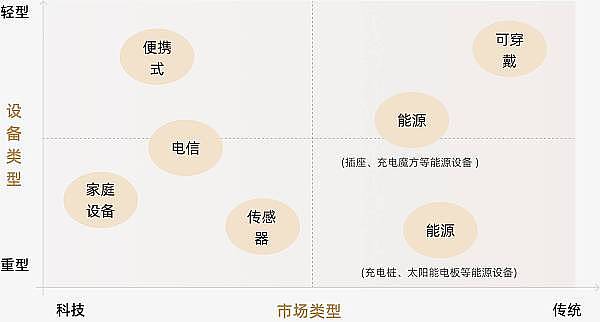
source: MT Capital
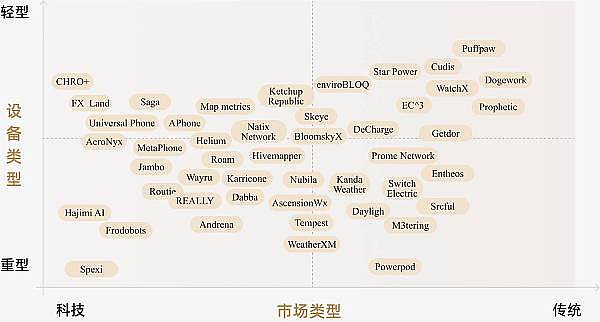
source: MT Capital
Track Mapping
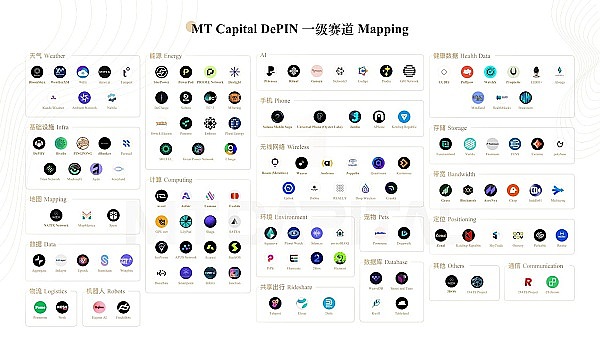
Sensor track
We define “sensor” as outdoor sensors, which help users collect various types of data such as maps, weather and vehicle information.After these outdoor sensors collect data, users can contribute their data to create a network of data value and receive corresponding token rewards.The DePIN project can aggregate data shared by these users, provide B-side customers with a more diverse data sample and capture commercial revenue from Web2.
Representative Project
Map Network
Hivemapper
Hivemapper is a decentralized map network that uses blockchain technology and crowdsourced dash recorder data to create detailed real-time maps.
Internet of Vehicles Data Network
DIMO
DIMO is a decentralized IoT vehicle data DePIN network that enables vehicle owners to collect, use and monetize data on their vehicles.
Positioning the network
Geodnet
GEODNET is a global decentralized network for global earth observations based on blockchain, using real-time dynamic technology (RTK) to significantly improve GPS accuracy.
Wireless network track
Mobile Wireless Network:
-
Market size and growth: It accounts for more than 76% of the market share in the telecommunications industry in 2022, which is driven mainly by 5G and IoT technologies.The compound annual growth rate is expected to be 6.2% from 2023 to 2030.
-
Function: Provide a wide range of personal and commercial connections through cellular technology.Supports various devices and applications to realize mobile communications and data services.
-
Future Outlook: Due to the increasing demand for higher bandwidth, advances in 5G technology, and integration of IoT devices, the demand for mobile wireless networks will become increasingly high.
Helium
Helium is a groundbreaking DePIN project that creates a decentralized wireless network that allows IoT devices to connect globally through distributed hotspot networks.
Fixed Wireless Access (FWA):
-
Market size and growth: As an alternative to wired broadband, especially in areas where cable laying is unrealistic, it is growing rapidly.The market size is expected to grow from 130 million connections at the end of 2023 to 330 million in 2029.
-
Function: Use radio waves to provide Internet services between fixed points.Usually deployed in areas where mobile wireless network services are insufficient, it is cheaper to lay out and easier to deploy than wireless mobile networks.
-
Future Outlook: Thanks to the improvement of 5G technology, FWA is expected to become a more common form of Internet access, especially in areas with insufficient infrastructure such as remote areas and rural areas.
Andrena
Andrena is a high-speed fixed unlimited access network service provider that uses cutting-edge radio technology to create high-speed, low-cost wireless networks in cities and regions where mobile wireless networks are underserved.
Wi-Fi network:
-
Market Size and Growth: The market value in 2023 is approximately US$14.5 billion and is expected to reach US$39.4 billion by 2028, with a CAGR of 22.2%.
-
Function: Provides LAN connection to the equipment through radio waves, supports a wide range of consumer electronic products from smartphones to household appliances, and is used in limited private spaces such as homes, businesses and public hotspots.
-
Future Outlook: Market growth will be driven by the increased demand for reliable Internet connectivity by smart devices and the increasing implementation of the Internet of Things in the public and private sectors.
Roam
Roam is a decentralized global WiFi network that provides enterprise-level OpenRoaming WiFi roaming services to the global public.
Energy track
Traditional energy markets face the following problems: supply and demand mismatch in regional energy networks, lack of transparent and tradable energy markets, large untapped clean energy markets, slow expansion of energy networks and high costs… However, DePIN can help shape the new generationCentralized energy network.
From a market perspective: The clean energy market is experiencing significant growth, with a market value currently at about USD 1.4 trillion, with a CAGR of 9.1% from 2022 to 2032.The renewable energy market is expected to grow from a market size of $881.7 billion to approximately $1.9 trillion in 2030, with an annual compound growth rate of about 8.4%.Energy DePIN projects have huge market space.
Power Plant:
StarPower
Starpower is a groundbreaking DePIN project aimed at revolutionizing energy management and distribution by leveraging decentralized networks of blockchain technology to create virtual power plants (VPPs).
Energy Trading
Daylight
Daylight is an open source blockchain network focused on creating decentralized markets for renewable energy and carbon credits, aiming to promote more sustainable energy transactions and use around the world.
Energy Storage
PowerPod
Powerpod aims to revolutionize the way electric vehicles (EVs) are charged by creating a shared, blockchain-powered network of charging stations.
Home Equipment Track
The home equipment field focuses on using decentralized technologies to enhance and optimize every aspect of daily life.This field addresses key issues such as high costs, privacy issues and uneven resource allocation, providing solutions by transforming standard home devices into decentralized network nodes.By using blockchain and other decentralized protocols, these devices provide low-cost, secure and efficient alternatives to traditional cloud services and computing power.This approach not only reduces dependence on centralized infrastructure, but also gives users greater control over data and resources.In addition, the integration of these devices not only enhances the smart home ecosystem and gaming experience, but also aims to enhance daily interactions and create a globally connected community.
FX land
FX Land provides a distributed cloud storage solution that addresses high storage fees and privacy issues through Crowd Storage nodes and Fula protocols.
Hajime AI
The Hajime AI project aims to create a global edge computing power supply network to provide cost-effective computing services to AI startups, solve the problem of uneven allocation of computing resources through decentralized platforms, and will also work with smart home and IoT ecosystems in the future.Seamless integration.
FrodoBots
The FrodoBots project uses real-world robots to solve the problem of embodied artificial intelligence (Embodied AI) through gamified methods.
Wearable Device Track
In the field of wearable devices, the focus is on combining smart wearable devices with blockchain technology.They use advanced artificial intelligence and data privacy protection technologies to provide personalized health monitoring and data management services.By enabling users to monetize their data and provide reward mechanisms, these devices motivate users to actively participate in health management.These devices are usually made of high-quality materials, with long battery life and strong waterproofing to ensure user convenience and safety.In addition, these smart wearable devices are compatible with mainstream mobile devices and cryptocurrency ecosystems, promoting widespread adoption of decentralized applications and Web3 ecosystems while improving users’ health and quality of life.
CUDIS
CUDIS is a stylish, groundbreaking AI smart ring that inspires users by rewarding their health journey.It has core features such as immutable data collection and control, personalized AI coaching, health motivational tasks and social activities.
WatchX
The WatchX project aims to integrate millions of smartwatch users into the Web3 ecosystem and provide a wide range of opportunities for partners within the ecosystem space.
Dogewalk
A DePIN platform integrates innovative software and hardware through GameFi and SocialFi elements to enhance the interaction between pet owners and Web3 users.
Portable equipment track
Portable features common features such as providing convenient mobile devices and applications to enhance the Web3 experience.They focus on simplifying user interaction, improving security, and implementing data ownership and reward mechanisms.These projects integrate hardware and software solutions to facilitate the development and use of decentralized applications, especially in mobile environments.The goal of this section is to drive the adoption and application of Web3 technology by lowering barriers to entry, optimizing user experience and providing practical application cases.
Solana Mobile Saga
The Solana Mobile Saga project aims to lead the Web3 mobile revolution by providing top-notch hardware and powerful developer resources to deliver a secure and user-friendly decentralized application experience.
Universal Phone Oyster Labs
The Universal Phone project, launched by Oyster Labs, aims to target 800 million Telegram users, focusing on emerging markets such as India, Indonesia and Nigeria.
Puffpaw
Puffpaw is a “Stop smoking and earn” project incubated by Arweave and OrangeDAO.Through e-cigarette devices and blockchain technology, help users quit smoking and receive financial rewards.
Token Economy of DePIN Project: Fixed Incentive Model Evolves into Dynamic Incentives
Inner logic analysis: Taking Helium as an example
Early incentive mechanism and its impact
In the early stages of the Helium project, early participants were able to receive very high token rewards by purchasing and deploying mining machines.This high yield attracted a large number of early users and quickly promoted the expansion of the network.However, this incentive mechanism also brings some problems:
The proportion of early participants’ profits was too high: early users quickly achieved high returns due to the acquisition of a large number of tokens.Although this phenomenon promoted the rapid growth of the network in the early stage, it also led to a rapid increase in the supply of tokens in the market.
Token Economic Volatility Adjustment: Due to the huge number of tokens in the hands of early participants, they began to sell tokens in the market, causing token prices to fluctuations and declines.When new users enter the market, they find that the yield rate is much lower than that of early users, resulting in a slowdown in new users’ growth.
Network growth stalls: As early high returns gradually disappear, new users’ willingness to enter decreases, and the network’s expansion slows down, slowing down project growth.
Introduction of dynamic incentive mechanisms
To address the above issues, the Helium project introduced dynamic incentives to ensure the continued growth and healthy development of the network.
Adjust incentives for new and old devices: Helium adjusts the incentive mechanism for new and old devices, so that users of new devices can also receive attractive rewards.For example, adding the initial reward for new devices will gradually reduce the proportion of rewards for outdated devices while maintaining network robustness to motivate users to purchase and deploy new devices.
Regional incentive policy: In order to promote the balanced development of the network on a global scale, Helium formulates differentiated incentive policies based on the equipment deployment in different regions.In areas with fewer devices, higher token rewards are provided to attract users to deploy devices in these areas.
Time period incentive adjustment: Helium balances network load and improves equipment utilization by providing different rewards at different times.For example, users who run devices during off-peak hours can receive additional rewards to ensure the network is running 24/7.
Equipment density excitation: In areas with low equipment density, Helium provides additional excitation to promote stable operation of the equipment and efficient data transmission.This not only improves user benefits, but also improves the overall performance of the network.
Specific implementation of dynamic incentives
The Helium project uses smart contracts and algorithms to implement dynamic incentive mechanisms to ensure real-time adjustment and fair distribution of incentives.These measures not only increase the enthusiasm of new users to participate, but also stabilize market expectations and prevent market fluctuations caused by early high returns.
Smart contract adjustment incentives: Through smart contracts, rewards for different devices are dynamically adjusted according to the use of devices and market demand.This mechanism ensures flexibility and real-timeness of incentives.
Real-time data feedback: By collecting and analyzing the operating data of the equipment, the Helium project can timely adjust the incentives in different regions and time periods to ensure the optimal configuration and utilization of network resources.
Transparent incentive mechanism: The transparency and openness of the dynamic incentive mechanism enhance users’ trust and encourage more users to participate in network construction.
Changes in incentives for new and old equipment
New device incentives: To lower the barriers to user entry, new devices usually have higher initial incentives to attract early adopters.Project parties may incentivize users to purchase and deploy new devices through high token rewards and lower initial costs, making it easier for new users to participate.
Old equipment maintenance incentives: To prevent users from abandoning old equipment, the project will provide continuous incentives, but these incentives may gradually decrease over time.Through equipment upgrade rewards and maintenance cost subsidies, the project party can adjust the operating costs of old equipment to ensure its continuous and effective operation.
Changes in the physical market
Equipment price adjustment: The project party will adjust the prices of different types of equipment according to market demand and the service life of the equipment.New equipment is usually more costly, but its incentives are higher due to capacity, supply and orders.Old equipment is cheaper, but it still gets stable returns, thereby attracting users at different levels.
Secondary market transactions: Equipment can be traded on the secondary market, the project party can charge a transaction fee and use part of the proceeds to repurchase and destroy tokens to support the token price.This method not only increases the liquidity of the device, but also stabilizes the value of the token.
Markets in different regions
Regional incentive policy: In order to promote the balanced deployment of equipment on a global scale, the project will formulate differentiated incentive policies based on market demand and development in different regions.For example, in areas with low device density, higher rewards may be provided to attract more device deployments, thereby achieving global coverage of the network.
Localization support: The project will provide localized technical support and training in different regions to help users better install and maintain equipment, improve equipment operation efficiency and user participation enthusiasm.This localized support can effectively promote the promotion and development of projects in various regions.
Equipment density
Intensity reward: In areas with lower equipment density, the project party may provide additional rewards to increase the lower density areas to promote the stable operation of the equipment and efficient transmission of data.These rewards can include higher token incentives and device upgrade subsidies, incentivizing users to keep the device running well.
Dynamic adjustment: The project party can dynamically adjust the equipment density in different regions based on real-time data to ensure the balanced development of the network and the optimal allocation of resources.Through such dynamic adjustments, the project party can flexibly respond to market changes and optimize network performance.
Equipment running time period
Time period reward: In order to balance network load and improve equipment utilization, project parties can set different rewards in different time periods.For example, devices operating during off-peak hours can receive additional incentives to ensure the network is running 24/7.
Load balancing mechanism: Project parties can dynamically adjust incentives for different time periods through smart contracts and algorithms to achieve balanced distribution of network load and optimal utilization of resources.Through this mechanism, the project party can effectively manage network resources and improve overall operational efficiency.
Summary and prospect
We believe that in the DePIN track, whether it is the classic DePIN or the new generation DePIN, it has enough categories and a broad market, and has the potential to create great projects with large-scale users to adopt.In the future, it is very likely that a Web3 project to enter the Top 20 will be born in this field.
The core logic of DePIN lies in the cost reduction and efficiency improvement of WEB3 for existing world businesses.By bringing real-world users to Web3, DePIN not only achieves low cost and socialization, but also greatly improves the number and accuracy of data sources.Among DePIN’s third-generation equipment, the market prospects continue to expand from fixed equipment to flexible and portable equipment, covering all kinds of needs of high technology and daily life.
In recent years, the types and investments of the DePIN market have increased significantly, and the number of institutions and projects has also continued to grow.From the demand side, DePIN shows great potential in multiple markets (such as weather, air quality, health, AI, etc.) and device types (such as wearable devices, mobile phones, etc.).The upstream and downstream industrial chains are also gradually improving, including on-chain interactive data, device intermediate layers, data and hardware.
It is particularly noteworthy that the life cycle of DePIN is theoretically longer than that of non-DePIN projects due to the combination of physical devices and token design.This makes the DePIN track have huge potential and deserves high attention and investment from investors.
Looking ahead, with the development of the DePIN project and the advancement of technology, we have reason to believe that this track will produce more innovative and influential projects, injecting new vitality and possibilities into the Web3 ecosystem.
Thanks for support:
Salvador @DAnconia_Crypto from EV3
Anna @gizmothegizzer from Solana
Raullen@raullen from IoTeX
Peter from Hashkey
EO @ Future money group
Reference:
-https://messari.io/report/state-of-depin-2023
-https://messari.io/report/infrastructure-sector-brief-gpu-networks
-https://messari.io/report/navigating-the-depin-domain
-https://messari.io/report/the-depin-sector-map
-https://public.bnbstatic.com/static/files/research/depin-an-emerging-narrative.pdf
-https://htxresearch.medium.com/depin-current-state-and-prospects-ad6b1a59b3d4
-https://nel4ibmr2ip7ahcw5g6plxbpavywdcgi6zjvb3bkizi632su4vta.arweave.net/aRfEBZHSH_AcVum89dwvBXFhiMj2U1DsKkZR7epU5WY
-https://foresightnews.pro/article/detail/50839
-https://twitter.com/rsarrow/status/1778471355425386928?s=46
MT Capital
MT Capital is a global investment institution managed by a team of senior investors, focusing on investing in innovative Web3 projects around the world, covering the United States, Hong Kong, Dubai and Singapore.Our main investment areas include: 1) Large-scale adoption: decentralized social platforms, games, applications and DEPINs, which are key to driving the spread of Web3 technology to a wide user base; 2) Encrypted native infrastructure: We focus onInvest in public chains, protocols and other infrastructure that supports and strengthens the ecosystem, as well as native DeFi solutions.In addition, our team also has many years of professional experience in secondary trading.






